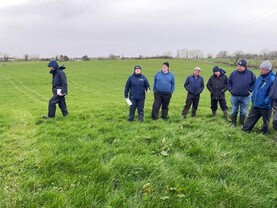Dry conditions: Farms in the northwest are having a textbook year, with hay saved in recent days along with good grass growth.
Further south it’s a different story, with soil moisture deficits starting to hit grass growth.
We are entering the driest month of the year so getting a huge amount of rain at this stage is unlikely. It’s important to take action early and avoid running into a major feed deficit now or next winter. If supplementary feed is introduced, you can stretch grass supplies and keep cattle moving into fresh grass every few days.
Fly activity has also increased so keep a close eye on dry cows and heifers for any signs of mastitis.
A question that is often asked is how quickly you can feed silage after ensiling. Silage needs to ferment before feeding so it’s best to leave it four weeks to become stable. Feeding bales from two weeks can take place if there are no other options. Hay is a good option to slow the rotation.
Water is vital during a very dry spell. Teagasc guidelines recommend suckler cows need up to 90 litres/day, weanlings need 20-25 litres/day, finishing cattle need 35-60 litres/day, and animals on ad-lib meals need up to 70 litres/day.
The risk of losing nitrogen to the atmosphere in the current conditions is high so it is advised to stop spreading fertiliser until rain is forecast and normal weather conditions return. Try not to top too much in the current conditions. With paddocks going to seed, the temptation is there to clean off paddocks after grazing. You are better to leave it until rain is forecast again.
Beef prices: Beef price has improved a lot in recent weeks. There is always a lull in supply during the summer before grass cattle start to come out in August. If you are finishing cattle off grass, take a look at them and see if you could pull some out of it to go a little earlier. Even if they are sold at lighter weights, the higher price will compensate. Feeding meal at grass for five to six weeks pre-slaughter will help to firm up the cattle and make sure they have the desired level of fat cover. Running animals across a scales is a great tool to assess where they are in terms of level of finish. Handling them will also help you decide what can go early.
Beef Conference: The Irish Grassland Association’s annual beef conference takes place online on Tuesday 6 July at 8pm. Viewers will get a chance to see inside the gates of one of Ireland’s largest suckler farms, Tateetra and Rathmore farms in Co Louth. Farm manager John Kingham has grown the herd to 500 cows and he will take viewers through what he does on the 1,000 acre farm, including breeding policy and grassland management.
The online conference will also talk to Allen Callagy, a beef finisher based in Co Kildare. Allen buys 100 weanlings every year. Viewers will see how Allen tries to maximise liveweight gain from grazed grass and what changes he has made to do this. Finally, Rory Mannion will outline Bord Bia’s new grass-fed standard and what it means for beef farmers. Viewers can log on to www.irishgrassland.ie at 8pm next Tuesday night to view the conference.






 This is a subscriber-only article
This is a subscriber-only article











SHARING OPTIONS: